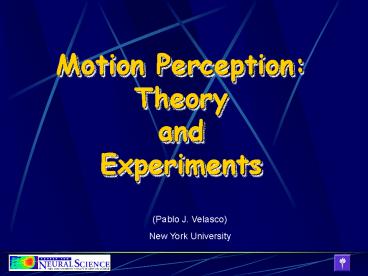Motion Perception: Theory and Experiments PowerPoint PPT Presentation
Title: Motion Perception: Theory and Experiments
1
Motion PerceptionTheoryandExperiments
(Pablo J. Velasco) New York University
2
Outline
- Goal
- Local cues the aperture problem
- From local to global INTEGRATION
- Hildreths model
- An interesting case the rotating ellipse
- Hildreths model predictions
- Psychophysics experiment
- To do
3
What we detectThe aperture problem
- V?
- VII ?
4
From local to globalINTEGRATION
Small receptive fields (input) LOCAL information
- (output) GLOBAL perception of motion
5
Hildreths model1
- Finding the velocity field
- V V(s)
- compatible with V?
Rigidity
1 Hildreth, E. C., The Measurement of Visual
Motion, The MIT Press, Cambridge, MA (1983)
6
Hildreths model
- Assumptions (constraint)
Smoothness
- Q
(Minimize)
7
Bayesian model2
- Probabilistic (Bayes rule)
Slowness
(Only translation)
- Probability
(Maximize)
2 Weiss, Y et al., Nature Neuroscience, 5, 598
(2002)
8
Ellipse Rotating
- Ambiguous stimuli ? illusions
Change of perception with ellipse eccentricity e
Give info about integration of local into global
9
What does Hildreths model predict?
- V minimum Q
QROT
QDEF
10
Experiment description
- Goal for a given e, find l.
- Present ellipse (e) rotating (2.5 sec).
- Add a bead on surface, rotating with a given
ltrial.
- Report whether the bead rotates faster or slower
than the ellipse.
11
Experiment description
l
- Psychometric function l for each e
12
(Preliminary) results
- Subject 1
Subject 2
13
To do
- Finish the psychophysics (capturing)
- Bayesian model
- 2D cues...
PowerShow.com is a leading presentation sharing website. It has millions of presentations already uploaded and available with 1,000s more being uploaded by its users every day. Whatever your area of interest, here you’ll be able to find and view presentations you’ll love and possibly download. And, best of all, it is completely free and easy to use.
You might even have a presentation you’d like to share with others. If so, just upload it to PowerShow.com. We’ll convert it to an HTML5 slideshow that includes all the media types you’ve already added: audio, video, music, pictures, animations and transition effects. Then you can share it with your target audience as well as PowerShow.com’s millions of monthly visitors. And, again, it’s all free.
About the Developers
PowerShow.com is brought to you by CrystalGraphics, the award-winning developer and market-leading publisher of rich-media enhancement products for presentations. Our product offerings include millions of PowerPoint templates, diagrams, animated 3D characters and more.

